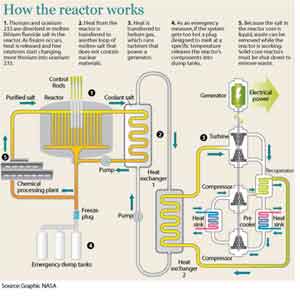Takashi Kamei zealously travels the globe pitching thorium, an alternative to uranium for which a commercial reactor application has proved elusive, writes April Yee of The National.
Takashi Kamei criss-crosses the globe with a packed briefcase, spreading his creed like an evangelist. His dream is straightforward: raise $300 million, build the world's first commercial thorium-fueled reactor, and then convince the world to copy it en masse.
Scientists have experimented with thorium as a safer alternative to uranium for atomic power plants for half a century, and ever since, a fanatic few have doggedly advocated bringing those designs to reality. Waste from thorium has a much shorter half-life, easing the dilemma of storing radioactive waste, and poses less of a risk of proliferation, they say.
Yet an integrated industry stretching from Moscow to Nigeria to the Andes of Argentina has been slow to give up supply chains and technology built around uranium. Thorium poses challenges too, because by itself it is not fissile enough to power a reactor, and if it did, it would produce dangerous gamma rays.
But the March 2011 triple meltdown at Japan's Fukushima nuclear plant has prompted a rethink. Italy, Switzerland, and Germany vowed to shut down nuclear plants early or abandon plans to build new ones, and in Japan all but two of the nation's 50 operational reactors are shut down.
"What I am doing myself has not changed after Fukushima, but the response has changed," says Kamei, the Japan representative of the International Thorium Energy Organization, based in Sweden, and the chief strategic officer of a startup called Quan Japan. "Because my reactor is much, much safer and so they recognize we need electricity."
Kamei was in Abu Dhabi last month to present his ideas at a conference and seek investors for Quan, which hopes to market a neutron accelerator to turn thorium into a fast-reacting fuel, since one of the problems with thorium is that it is difficult to spark a reaction. In October, Quan signed an agreement with Altay, a technopark in thorium-rich Kazakhstan, to jointly research nuclear applications for the material.
Hundreds of thousands of tons of thorium reserves are said by geologists to exist there and in the United States, Brazil, Australia, India, and China. India and China are experimenting with using small amounts of thorium in traditional uranium fuel assemblies.
Today, thorium research—which last peaked in the 1960s when Tennessee's Oak Ridge National Laboratory built a pilot reactor—is enjoying a global renaissance. China has recruited 140 doctoral scientists for a $350 million research program and aims to bring on another 610 top brains.
Norway's aptly titled Thor Energy—thorium is named after the Norse god of thunder—launched in December a four-year pilot for the use of thorium in an existing uranium reactor.
And at the Massachusetts Institute of Technology, two young doctoral candidates have launched a company called Transatomic that aims to build a "waste-annihilating molten salt reactor", running on a combination of waste from traditional uranium reactors and either uranium or thorium.
Kamei started his nuclear engineering studies at Kyoto University in 1988. His academic choice was motivated by oil price shocks and a desire, after disasters at the Three Mile Island in the US and the Soviet Union's Chernobyl, to learn more about atomic power.
"I was very confused whether I should select nuclear power," he recalls. "But at that time I was just 18 years old, so I decided to study nuclear power, because if we don't know, we cannot evaluate whether this path is wrong."
As he racked up a decade of degrees—a bachelor's, master's, and a doctorate—scant time in the lecture hall was devoted to thorium.
"But at the end of the 1990s, just coming to the 21st century, I thought that the nuclear industry or nuclear power is not good, because mostly the nuclear industry did not pay attention to the severe accidents such as Fukushima and they did not pay attention to the nuclear nonproliferation," he says. "And then I started to think about using thorium."
With the conviction of a convert, he looked at the possibility of using the world's existing plutonium supplies—a byproduct of uranium-fueled reactors that is both highly radioactive and useful for making a nuclear weapon—as a spark to ignite the "match" of thorium. A thorium reactor would require extra layers of protective cladding to protect workers from gamma rays, but it would not cost more to build, he reasoned.
In 2011, the year of Fukushima, he started Quan. Last week, he was on his way to Australia to discuss the possibilities of a thorium reactor and continue recruiting investors to build the $300 million pilot. But change seems as glacial as a meltdown is fast—so far not one investor has signed on.






















